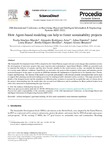How Agent-based modeling can help to foster sustainability projects

Use this link to cite
http://hdl.handle.net/2183/32003
Except where otherwise noted, this item's license is described as Atribución-NoComercial-SinDerivadas 3.0 España
Collections
- Investigación (FEDU) [938]
Metadata
Show full item recordTitle
How Agent-based modeling can help to foster sustainability projectsAuthor(s)
Date
2022Citation
Sánchez-Maroño, N., Rodríguez-Arias, A., Dumitru, A., Lema-Blanco, I., Guijarro-Berdiñas, B., & Alonso-Betanzos, A. (2022). How Agent-based modeling can help to foster sustainability projects. Procedia Computer Science, 207, 2546-2555
Abstract
[Abstract] The Sustainable Development Goals (SDGs) adopted by the United Nations require relevant social changes that sometimes involve the development of innovative projects that cause rejection and confrontation. Agent-Based Models (ABM) are powerful tools to represent the behavior of systems, and they have become valuable for the social sciences as they can simulate the behavior of a society under different conditions. Superblocks are innovative city projects that reorganize urban space and minimize private motorized transport. In this paper, we present an ABM that simulates the implantation of superblocks in two Spanish cities: Vitoria-Gasteiz and Barcelona. The interest of this model is to provide policymakers with relevant scientific information that can be used to support their planning and decision-making processes by running possible alternative policy scenarios. This paper presents the details of the designed model and the simulation of different policy scenarios to increase the acceptability rates of citizens about the project, demonstrating how the model takes into account local differences and its usefulness for those political leaders from other cities interested in implementing this type of project.
Keywords
Artificial intelligence
Agent based modeling
Humat model
Sustainability
Social innovation
Superblocks
Agent based modeling
Humat model
Sustainability
Social innovation
Superblocks
Editor version
Rights
Atribución-NoComercial-SinDerivadas 3.0 España






